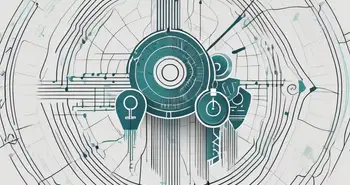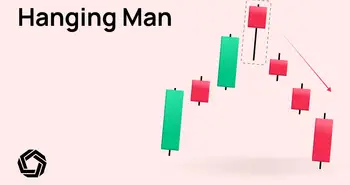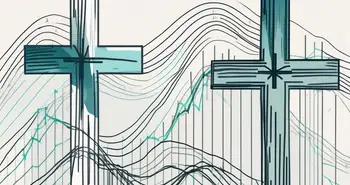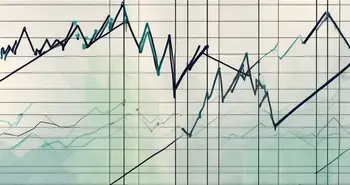The Continuation Patterns in Trading

As a seasoned trader, I have come to fully understand and appreciate the power of continuation patterns in the world of trading. These patterns provide valuable insights into market trends and can help traders make informed decisions for maximum profit. In this article, I will guide you through the fascinating realm of continuation patterns, teaching you how to identify and utilize them to unlock your true trading potential.
Understanding Continuation Patterns
Defining Continuation Patterns in Trading
Continuation patterns, as the name suggests, are chart patterns that indicate a temporary pause in a prevailing market trend before it eventually continues. These patterns occur when the market takes a breather, consolidating its gains or losses, before resuming its original trajectory. By recognizing these patterns, traders can gain a deeper understanding of market movements and effectively predict future price movements.
One common continuation pattern is the ‘Flag' pattern, characterized by a sharp price movement followed by a brief consolidation, forming a rectangular shape on the chart. This pattern signifies a temporary pause in the market trend before it continues in the direction of the initial price movement. Traders often look for flags as they provide valuable insights into potential future price action.
The Importance of Continuation Patterns
Continuation patterns serve as vital guides for traders, serving two main purposes. Firstly, they confirm the presence of an ongoing trend, reaffirming a trader's confidence in holding onto their current positions. This confirmation gives traders the assurance they need to stay steadfast and reap the full benefit of a trend's continuation. Secondly, continuation patterns help traders identify potential entry points, enabling them to join the trend and capitalize on its future momentum.
Another significant continuation pattern is the ‘Pennant,' which resembles a small symmetrical triangle that forms after a strong price movement. The pennant pattern indicates a brief consolidation period before the market trend resumes, similar to the flag pattern. Traders often use the pennant pattern as a signal to anticipate a breakout or breakdown, depending on the direction of the preceding price movement.
Types of Continuation Patterns
Bullish and Bearish Patterns
Continuation patterns can be classified into bullish and bearish patterns, depending on the prevailing trend. Bullish patterns indicate a temporary pause in a rising market trend before it continues its upward trajectory. On the other hand, bearish patterns occur during a downtrend, signaling a brief consolidation before further downside movement. By identifying the type of continuation pattern, traders gain insight into the nature of the upcoming price action, allowing them to tailor their trading strategies accordingly.
Understanding the nuances of bullish and bearish continuation patterns is essential for traders looking to capitalize on market trends effectively. Bullish patterns, such as the cup and handle pattern or the ascending triangle pattern, often suggest a period of consolidation before a potential breakout to higher prices. Conversely, bearish patterns like the descending triangle or the head and shoulders pattern typically indicate a temporary pause in a downtrend before the resumption of bearish momentum.
Common Continuation Patterns
There are several common continuation patterns that traders often encounter in the financial markets. These patterns include the flag pattern, pennant pattern, triangle pattern, and wedge pattern, among others. Each pattern has its own unique characteristics and implications, providing traders with valuable clues about the future direction of prices. Familiarizing yourself with these patterns will ultimately enhance your ability to make accurate predictions and execute winning trades.
The flag pattern, for instance, is characterized by a sharp price movement followed by a rectangular consolidation, resembling a flag on a pole. This pattern typically indicates a brief pause before the continuation of the prior trend, offering traders a potential entry point for profitable trades. Similarly, the pennant pattern is formed by converging trendlines, representing a period of consolidation before a breakout in the direction of the prevailing trend. Recognizing these common continuation patterns can give traders a competitive edge in navigating dynamic market conditions.
Identifying Continuation Patterns
Recognizing Patterns in Trading Charts
Identifying continuation patterns on trading charts requires a keen eye and sound technical analysis skills. Traders should look for distinct price patterns characterized by consolidation or sideways movement. These patterns often form after a significant price move in one direction, indicating that market participants are taking a breather before pushing the price in the original trend's direction once again. Utilizing candlestick patterns and charting tools can greatly assist in recognizing these formations and increasing trading success.
Tools for Identifying Continuation Patterns
To enhance pattern recognition, skilled traders often employ various technical analysis tools. Moving averages, trendlines, and oscillators are just a few examples of tools that can be used to validate the presence of a continuation pattern. By combining multiple indicators and analyzing them in conjunction with chart patterns, traders can generate powerful signals and increase the accuracy of their trading decisions.
Strategies for Trading with Continuation Patterns
Timing Trades with Continuation Patterns
Timing is crucial when trading with continuation patterns. Traders need to wait for a pattern to fully form before entering a trade. Patience is key, as premature entries can lead to false signals and potential losses. By waiting for confirmation and ensuring proper pattern structure, traders can significantly increase their success rate and maximize their profits.
Risk Management in Continuation Pattern Trading
As with any form of trading, risk management is of paramount importance when utilizing continuation patterns. Setting appropriate stop-loss orders and adhering to a risk-reward ratio is crucial for preserving capital and minimizing potential losses. Continuation patterns may not always result in the expected outcome, so employing sound risk management strategies is essential for long-term success.
Overcoming Challenges in Continuation Pattern Trading
Avoiding Common Mistakes
Even experienced traders can fall victim to common mistakes when trading continuation patterns. One common pitfall is interpreting a pattern incorrectly or prematurely, leading to poor trading decisions. It is vital to thoroughly analyze patterns and gather supporting evidence before entering a trade. Additionally, emotional decision-making can cloud judgment and result in impulsive trades. Maintaining discipline and sticking to a well-defined trading plan can help overcome these challenges.
Tips for Successful Continuation Pattern Trading
In my years of trading, I have gleaned a few insider tips that have greatly contributed to my success with continuation patterns. Firstly, keep your focus on the bigger picture and consider the context in which the continuation pattern occurs. Secondly, do not solely rely on one indicator or tool; instead, employ a combination of technical analysis tools to confirm the presence of a continuation pattern. Lastly, never underestimate the power of practice and continuous learning. The more you immerse yourself in analyzing charts and studying patterns, the more adept you will become at identifying and utilizing continuation patterns.
Remember, trading is an art that requires a blend of knowledge, experience, and intuition. By mastering the art of continuation patterns, you can unlock the true power of trading and propel yourself towards financial success. Happy trading!
FAQ
What are continuation patterns?
Continuation patterns are chart patterns that indicate a temporary pause in a prevailing market trend before it resumes its original trajectory.
Why are continuation patterns important?
Continuation patterns confirm ongoing trends, allowing traders to have confidence in their positions, and also serve as entry points for joining a trend.
What are some common continuation patterns?
Common continuation patterns include the flag pattern, pennant pattern, triangle pattern, and wedge pattern.
How can I identify continuation patterns?
Continuation patterns can be recognized through careful analysis of chart formations and the use of technical indicators and tools.
What strategies should I employ when trading with continuation patterns?
Timing trades correctly and implementing effective risk management strategies are key strategies for trading with continuation patterns.
What are some challenges in continuation pattern trading?
Some challenges include avoiding common mistakes, such as premature interpretations, and overcoming emotional decision-making.
Do you have any tips for successful continuation pattern trading?
Some tips include considering the bigger picture, using multiple indicators for confirmation, and continuous practice and learning.
Ready to put your knowledge of continuation patterns into practice? Look no further than Morpher, the revolutionary trading platform that's changing the game with blockchain technology. With Morpher, you can trade a vast array of assets, from stocks and crypto to the most unconventional markets, all with zero fees and infinite liquidity. Whether you're looking to invest fractionally with as little as $1, short sell without interest fees, or leverage your trades up to 10x, Morpher provides the safety, control, and unique trading experience you need. Embrace the future of investing and Sign Up and Get Your Free Sign Up Bonus today to unlock your true trading potential on a platform that's as innovative as your strategies.

Disclaimer: All investments involve risk, and the past performance of a security, industry, sector, market, financial product, trading strategy, or individual’s trading does not guarantee future results or returns. Investors are fully responsible for any investment decisions they make. Such decisions should be based solely on an evaluation of their financial circumstances, investment objectives, risk tolerance, and liquidity needs. This post does not constitute investment advice.

Painless trading for everyone
Hundreds of markets all in one place - Apple, Bitcoin, Gold, Watches, NFTs, Sneakers and so much more.

Painless trading for everyone
Hundreds of markets all in one place - Apple, Bitcoin, Gold, Watches, NFTs, Sneakers and so much more.









